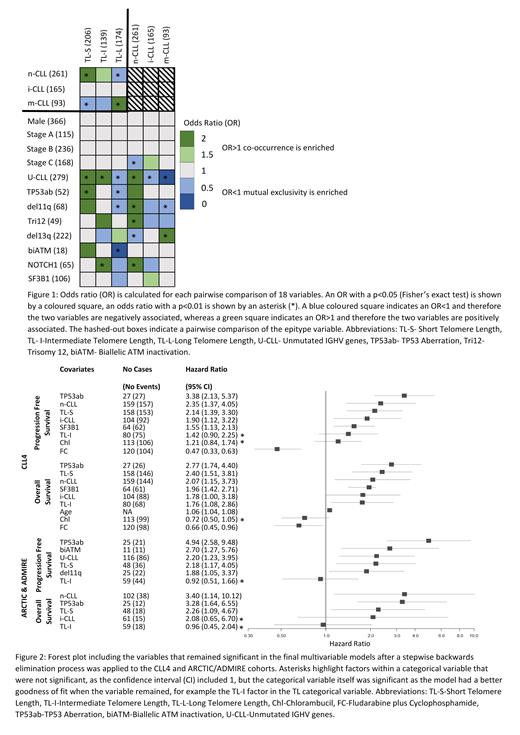The presence of TP53 aberrations ( TP53ab) and/or unmutated IGHV genes (U-CLL) helps select initial treatment for CLL patients (Hallek 2018 & Walewska 2022). However, many other biomarkers identified in recent years have failed to impact clinical decisions due to their coexistence with poor-risk indicators and uncertainty in their predictive abilities, often without suitable validation in long-term Phase II/III trials with comprehensive molecular analysis.
We evaluated the clinical significance of two biomarkers, DNA methylation-based epitype (DME) and telomere length (TL), in (immuno-)chemotherapy clinical trials using samples from UKCLL4 (n=304) and ARCTIC/ADMIRE (ARC/ADM) (n=215). To our knowledge, DME and TL have not been assessed in a single study. Therefore, we utilized previously published DME (Wojdacz, 2019) and TL data (Strefford, 2015 & Norris, 2019), supplemented with new MMQ-PCR data (n=60). TL cut-offs of short (TL-S, <2.92kb), intermediate (TL-I, 2.92-3.57kb), and long (TL-L, >3.57kb) and DME classifications of n-CLL (naive B-cell-like), i-CLL (intermediate B-cell-like) and m-CLL (memory B-cell-like) were employed.
73% of m-CLL and 50% of n-CLL patients harboured TL-L and TL-S, respectively (p<0.001, Figure 1). Additionally, n-CLL and TL-S were associated with poor-risk indicators, such as TP53ab and del(11q) (p<0.05, Figure 1). We then assessed the impact of 10 clinico-biological features, including DME, TL, age and treatment arm, on progression-free survival (PFS) and overall survival (OS) in CLL4 and ARC/ADM cohorts using univariate analysis (UA). The n-CLL group exhibited the shortest PFS and OS in the ARC/ADM cohort (PFS hazard ratio (HR):4.47, 95% confidence interval (CI):2.56-7.82 & OS HR:3.95, CI:1.66-9.35, p<0.01), greater than the presence of TP53ab (PFS HR:4.39, CI:2.69-7.17 & OS HR:3.77, CI:1.94-7.33, p<0.001). In CLL4, whilst TP53ab was the strongest predictor of PFS and OS (PFS HR:3.61, CI:2.39-5.44 & OS HR: 3.66, CI:2.4-5.57, p<0.001), both n-CLL (PFS HR:1.96, CI:1.32-2.9 & OS HR:2.8, CI:1.81-4.34, p<0.001) and TL-S (PFS HR:2.36, CI:1.7-3.29 & OS HR:2.66, CI:1.87-3.76, p<0.001) were in the top five predictors of PFS and OS along with U-CLL and biallelic ATM inactivation ( biATM). Next, we performed Kaplan-Meier subgroup analysis, investigating DME in TL subgroups and vice versa. Examination of both biomarkers in the opposing subgroups in the ARC/ADM cohort, showed that TL could further stratify the i-CLL subgroup, with TL-L predicting longer PFS (median:6.12 years) compared to TL-S (HR:5.78, CI:2.34-14.33, median:3.8 years, p<0.001) or TL-I (HR:3.29, CI:1.4-7.76, median:4.35 years, p<0.01). As this pairwise analysis suggested that DME and TL may differentially contribute to outcome, we performed a multivariate cox regression, whilst controlling for confounding variables such as TP53ab and U-CLL. Covariates that were significant in UA were included in a stepwise backwards elimination process until a final model was reached. The CLL4 models were based on 246 subjects with 221 PFS and 205 OS events, ARC/ADM models were based on 138 and 176 subjects with 86 and 45 events for PFS and OS, respectively. For PFS models, TL-S emerged as significant (CLL4 HR:2.14, CI:1.39-3.3, p<0.001 & ARC/ADM HR:2.18, CI:1.17-4.05, p<0.01) with a HR lower than TP53ab (CLL4 HR:3.38, CI:2.13-5.37 & ARC/ADM HR:4.94, CI:2.58-9.48, p<0.001). DME emerged as significant for PFS in the CLL4 cohort (n-CLL HR:2.35, CI:1.37-4.05, p<0.01), along with SF3B1 mutation and treatment arm (Figure 2). In ARC/ADM, U-CLL, TP53ab, TL-S, del11q and biATM emerged as significant predictors of PFS (Figure 2). For OS, in both cohorts, TP53ab (CLL4 HR:2.77, CI:1.74-4.4, p<0.001 & ARC/ADM HR:3.28, CI:1.64-6.55, p<0.001) and DME (CLL4 HR:2.07, CI:1.15-3.73, p<0.05 & ARC/ADM, HR:3.4, CI:1.14-10.12, p<0.05) were found to predict shorter survival (Figure 2). Currently, we are integrating additional IGHV/IGLV data into our analysis, including the presence of IGLV3-21R110.
In conclusion, by assessing the individual contribution of DME and TL to disease survival, we found that both variables offer valuable independent prognostic information when included in statistical models with poor-risk genomic lesions. TL and DME could help identify IGHV-mutated patients destined to respond poorly to (immuno-)chemotherapy, that might be more favourably treated with targeted agents.
Disclosures
Pettitt:Celgene: Research Funding; Chugai: Research Funding; Gilead: Research Funding; GSK/Novartis: Research Funding; Napp: Research Funding; Roche: Research Funding. Hillmen:Apellis Pharmaceuticals: Current Employment, Current equity holder in publicly-traded company. Walewska:AbbVie, AstraZeneca, Janssen, Beigene: Other: meeting attendancies. Baird:TeloNostiX Ltd: Current equity holder in private company, Patents & Royalties: U.S. Patent No 10,378,065.


This feature is available to Subscribers Only
Sign In or Create an Account Close Modal